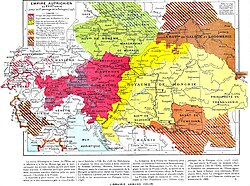Oltenia
Oltenia | |
|---|---|
 | |
|
UTC+3 (EEST ) |
Oltenia (Romanian pronunciation:
History
| History of Romania |
|---|
 |
|
|
Ancient times

Initially inhabited by
Middle Ages

From 681, with some interruptions, it was part of the Bulgarian Empire (see Bulgarian lands across the Danube).[citation needed]

In 1233, the Kingdom of Hungary formed the Banate of Severin in the western part of the region that would persist until the 1526 Battle of Mohács.
Around 1247, a polity emerged in Oltenia under the rule of
During the 15th century, Wallachia had to accept the Ottoman suzerainty and to pay an annual tribute to keep its autonomy as a vassal. From the Craiovești family, many bans cooperated with the Turks. However, many rulers, including the Oltenian-born Michael the Brave, fought against the Ottomans, giving Wallachia brief periods of independence.
Modern times
After 1716, the Ottomans decided to cease choosing the voivodes from among the Wallachian boyars, and to appoint foreign governors. As the governors were Orthodox Greeks living in

Two years later, in 1718 under the terms of the
In 1761, the residence of Bans was moved to Bucharest, in a move towards centralism (a kaymakam represented the boyars in Craiova). It remained there until the death of the last Ban, Barbu Văcărescu, in 1832.
In 1821, Oltenia and Gorj County were at the center of Tudor Vladimirescu's uprising (see Wallachian uprising of 1821). Vladimirescu initially gathered his Pandurs in Padeș and relied on a grid of fortified monasteries such as Tismana and Strehaia.
Symbols
The traditional heraldic symbol of Oltenia, also understood to represent Banat, is part of the coat of arms of Romania (lower dexter): on gules field, an or lion rampant, facing dexter, holding a sword, and standing over an or bridge (Apollodorus of Damascus Bridge at Drobeta Turnu Severin) and stylised waves.
Since its promulgation on 13 April 2017, Oltenia Day is officially celebrated on 21 March.[2]
Geography


Oltenia is part of the
Oltenia's main city and seat for a majority of the late
Towns
|
City |
County |
Population |
|---|---|---|
| Craiova | Dolj | 302,601 |
| Râmnicu Vâlcea | Vâlcea | 107,656 |
| Drobeta-Turnu Severin | Mehedinți | 92,617 |
| Târgu Jiu | Gorj | 82,504 |
| Slatina | Olt | 63,487 |
| Caracal | Olt | 34,603 |
| Motru | Gorj | 25,860 |
| Balș | Olt | 23,147 |
| Drăgășani | Vâlcea
|
22,499 |
| Băilești | Dolj | 22,231 |
| Corabia | Olt | 21,932 |
| Calafat | Dolj | 21,227 |
| Filiași | Dolj | 20,159 |
| Dăbuleni | Dolj | 13,888 |
| Rovinari | Gorj | 12,603 |
| Strehaia | Mehedinți | 12,564 |
| Bumbești-Jiu | Gorj | 11,882 |
| Băbeni | Vâlcea | 9,475 |
| Târgu Cărbunești | Gorj | 9,338 |
| Călimănești | Vâlcea | 8,923 |
| Segarcea | Dolj | 8,704 |
| Turceni | Gorj | 8,550 |
| Brezoi | Vâlcea | 7,589 |
| Tismana | Gorj | 7,578 |
| Horezu | Vâlcea | 7,446 |
| Vânju Mare | Mehedinți | 7,074 |
Piatra Olt
|
Olt | 6,583 |
| Novaci | Gorj | 6,151 |
| Bălcești | Vâlcea | 5,780 |
| Baia de Aramă | Mehedinți | 5,724 |
| Berbești | Vâlcea | 5,704 |
| Țicleni | Gorj | 5,205 |
Băile Olăneşti
|
Vâlcea | 4,814 |
| Bechet | Dolj | 3,864 |
| Ocnele Mari | Vâlcea | 3,591 |
| Băile Govora | Vâlcea | 3,147 |
References
- ^ Ingrao, Samardžić & Pešalj 2011.
- ^ "Ziua Olteniei". Agerpres (in Romanian). 21 March 2020. Archived from the original on 20 April 2021. Retrieved 20 March 2021.
Sources
- Vlad Georgescu, Istoria ideilor politice românești (1369–1878), Munich, 1987
- Neagu Djuvara, Între Orient și Occident. Țările române la începutul epocii moderne, Humanitas, Bucharest, 1995
- Constantin C. Giurescu, Istoria Bucureștilor. Din cele mai vechi timpuri pînă în zilele noastre, Ed. Pentru Literatură, Bucharest, 1966, p. 93
- Șerban Papacostea, Oltenia sub stăpânirea austriacă (1718–1739), Bucharest, 1971, p. 59
- Ingrao, Charles; Samardžić, Nikola; Pešalj, Jovan, eds. (2011). The Peace of Passarowitz, 1718. West Lafayette: Purdue University Press. ISBN 9781557535948.
External links
